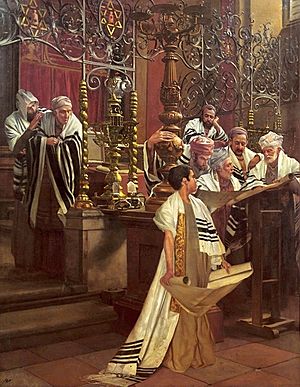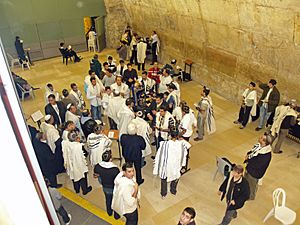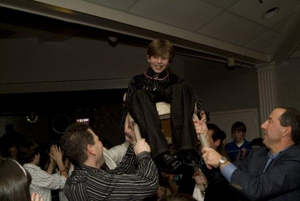Bar and bat mitzvah facts for kids
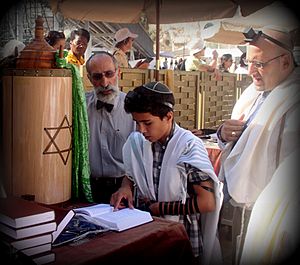
Bar mitzvah boy (middle) wearing tallit and tefillin
|
|
| Native name | bar mīṣvā: בַּר מִצְוָה bat mīṣvā: בַּת מִצְוָה |
|---|---|
| Time |
|
| Type | Coming-of-age ceremony |
| Theme | Reaching the age of bar or bat mitzvah signifies becoming a full-fledged member of the Jewish community |
A bar mitzvah (for boys) or bat mitzvah (for girls) is a special coming-of-age ceremony in Judaism. When Jewish children reach a certain age, they are seen as adults in the Jewish community. This means they become responsible for their own actions and for following Jewish laws.
Traditionally, parents are responsible for their children's actions before this age. Once a child becomes bar or bat mitzvah, they are responsible for themselves. This is a big step!
In Orthodox Jewish communities, boys become bar mitzvah at 13 and girls become bat mitzvah at 12. In most Reform, Reconstructionist, and Conservative communities, it's usually 13 for both boys and girls. After this, young people can take part in all areas of Jewish community life, just like adults. For example, a bar mitzvah boy can be counted in a Minyan (a group of ten adults needed for some prayers).
The idea of bar mitzvah has been around for a long time, mentioned in ancient Jewish texts. The age of b'nai mitzvah (plural for bar and bat mitzvah) usually happens around the time of puberty. The ceremony often takes place on the first Shabbat (Sabbath) after the birthday when the child reaches the right age.
Contents
What do the words mean?
The word Bar comes from Aramaic and means "son." The word bat comes from Hebrew and means "daughter." The word mitzvah means "commandment" or "law."
So, bar mitzvah means "son of commandment," and bat mitzvah means "daughter of commandment." This means the person is now "subject to the law" or responsible for following Jewish laws. While people often use the term for the ceremony, it originally refers to the person themselves.
How the tradition started
The way we celebrate bar and bat mitzvah today didn't exist in ancient times. However, early Jewish writings say that boys become adults by law at age 13. The celebration of this special occasion started to appear in the Middle Ages (around 500 to 1500 CE).
Why age 13?
The Bible doesn't directly say age 13. But ancient Jewish texts, like the Mishnah, mention this age. It says: "At five years old one should study the Scriptures, at ten years for the Mishnah, at 13 for the commandments..."
Other texts also list 13 as the age when someone becomes responsible for following the Torah's commandments. For example, it's said that a person's "good inclination" (their desire to do good) starts to become strong at age 13.
The term "bar mitzvah"
The term "bar mitzvah" first appears in the Talmud. It meant "someone who is subject to the law," but it didn't refer to age back then. The term "bar mitzvah" for the age of maturity became common around the 14th century.
Early celebrations
Some old Jewish writings from the Middle Ages talk about a synagogue ceremony for boys turning 13.
One text says that when an Israelite boy becomes of age, he is brought to the synagogue and school to praise God. Another text from Jerusalem mentions bringing the Bar Mitzvah boy before a priest or elder for a blessing and prayer.
Later on, there are mentions of a festive celebration. One text says: "It is a mitzvah (good deed) for a person to make a meal on the day his son becomes Bar Mitzvah as on the day he enters the wedding canopy." This shows that parties became part of the tradition.
What it means to be Bar or Bat Mitzvah
Becoming bar or bat mitzvah means you are a full member of the Jewish community. You gain new responsibilities and rights. These include:
- Being responsible for your own actions.
- Being able to be called to read from the Torah.
- Being able to lead or take part in a minyan (prayer group).
- Having the right to own property and marry according to Jewish law.
- The duty to follow the 613 laws of the Torah.
- Being able to be a witness in a Jewish court.
Many synagogues ask young people preparing for their bar or bat mitzvah to attend services, study at a Hebrew school, and do a charity or community service project. They might also hire a tutor to help them learn Hebrew, how to chant from the Torah, and basic Jewish ideas.
The Reform Jewish movement in North America once thought about replacing bar and bat mitzvah with a different ceremony called "confirmation." However, the bar and bat mitzvah tradition remained very popular and is now celebrated by almost all Reform Jews.
Reading from the Torah
A common practice is for the young person to be called up for an aliyah on a Shabbat shortly after their birthday. An aliyah is when someone is called to stand at the Torah and say blessings before and after a section of the Torah is read.
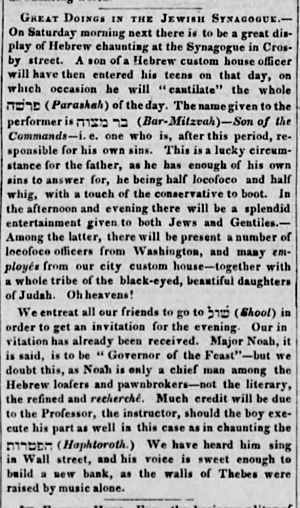
The Torah is divided into seven main sections for the weekly reading, plus an eighth section called maftir. The maftir is also connected to the reading of that day's Haftarah section from the Prophets. It is most common for the bar or bat mitzvah child to read the maftir section.
In most synagogues, a special person called the ba'al korei reads all the Torah parts. The person having the aliyah only says the blessings. However, a bar mitzvah boy might learn to read the entire service, or just his aliyah, or the haftorah. This takes a lot of practice, sometimes a year of study, and is a great achievement.
In Reform, Reconstructionist, and Conservative synagogues, girls can also have an aliyah and read from the Torah. In Orthodox synagogues, only boys can have an aliyah. However, in some modern Orthodox communities, girls might give a d'var Torah (a talk about the weekly Torah portion) at the end of the service.
Sometimes, the celebration is delayed for family reasons, but the young person still becomes a Jewish adult at the correct age, regardless of when the party happens.
Wearing Tefillin
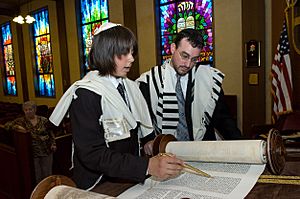
When a boy becomes bar mitzvah, he is now old enough to wear tefillin. These are small black leather boxes containing scrolls of parchment with verses from the Torah. They are worn on the arm and head during weekday morning prayers.
Many boys start practicing wearing tefillin a month or two before their bar mitzvah. This way, they know how to wear them correctly by the time they are required to.
Bar and Bat Mitzvah Parties
Since the 13th century, it has been a tradition to have a party after the synagogue ceremony. This party is often called a seudat mitzvah, which means a "meal of commandment." It's a happy meal with family, friends, and community members.
At the party, the bar or bat mitzvah might give a speech or talk. Guests often give presents. The rabbi or teacher might also give a blessing.
Some families celebrate in other ways, like taking a special trip or organizing a unique event. In many communities, the young person receives a certificate.
In the past, some Jewish leaders limited how big and fancy these parties could be. For example, in 1730 in Berlin, only ten men were allowed to attend the party. These rules were often made to avoid upsetting non-Jewish neighbors and to keep the celebration smaller than a wedding.
Today, some bar and bat mitzvah parties, especially among wealthy families, can be very grand. They might be held at hotels with hundreds of guests. Some rabbis have expressed concern that these parties can become too focused on the celebration rather than the religious meaning.
In 1992, the Union of American Hebrew Congregations (now the Union for Reform Judaism) passed a resolution against "wasteful spending" on parties. They encouraged "family togetherness, true friendship, acts of tzedakah (charity), and parties suitable for children."
The cost of a party can vary a lot. Some families spend a lot of money on renting venues, decorations, and hiring DJs, entertainers, and dancers. However, these celebrations are usually less expensive than a wedding for the same family.
Bat Mitzvah Customs
Today, many non-Orthodox Jews celebrate a girl's bat mitzvah in a similar way to a boy's bar mitzvah. In all Reform and Reconstructionist, and most Conservative synagogues, girls and women can read from the Torah and lead services. In Orthodox communities, a girl's bat mitzvah is celebrated when she turns 12.

Most Orthodox Jews believe that women should not publicly read from the Torah or lead prayer services when a minyan (quorum of 10 males) is present. However, public celebrations for girls becoming bat mitzvah have become more common in Modern Orthodox Judaism. In these communities, girls might give a talk about a Jewish topic, learn a book of the Tanakh (Hebrew Bible), or say prayers. In some Modern Orthodox groups, bat mitzvah girls might read from the Torah and lead prayers in a women-only prayer group.
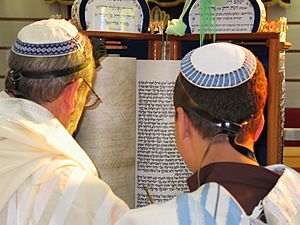
The first public celebration of a bat mitzvah in the United States was for Judith Kaplan in 1922. Her father, Rabbi Mordecai Kaplan, held the ceremony at his synagogue in New York City. Judith read a part of the weekly Torah portion in Hebrew and English. This event helped make bat mitzvah ceremonies more accepted for girls in non-Orthodox Jewish communities.
As the ceremony became accepted for girls, many women who didn't have a bat mitzvah as children chose to celebrate it later in life. This was a way to formally celebrate their place in the adult Jewish community.
Other types of ceremonies
Some Humanist Jews might choose to write a research paper on a Jewish history topic instead of reading from the Torah. Secular Jewish schools also encourage young people to pick a topic about their Jewish identity.
In Israel, the kibbutz movement also encouraged bar mitzvah celebrations. Young people would research a Jewish or Zionist topic. Today, many kibbutz children are choosing more traditional bar mitzvah celebrations.
Some men who reach the age of 83 celebrate a "second bar mitzvah." This is based on the idea that a normal lifespan is 70 years, so an 83-year-old can be seen as 13 in a "second lifetime." This tradition is becoming more common as people live longer, healthier lives.
A bark mitzvah is a fun, non-religious celebration for a dog's coming of age. It's a playful take on the traditional bar and bat mitzvahs.
Gifts
It's common to give gifts to the young person celebrating their bar or bat mitzvah. Traditional gifts include books about religion or education, religious items, or money. It's very common to give money in multiples of 18. This is because the Hebrew word for "life," chai, has a numerical value of 18. So, gifts in multiples of 18 are seen as bringing good luck and blessings for life.
Many young people also receive their first tallit (prayer shawl) from their parents to wear for the ceremony. Boys might also receive tefillin. Jewelry is a popular gift for girls. Another traditional gift for a bat mitzvah girl is Shabbat candlesticks, as lighting the Shabbat candles is an important tradition for women in Jewish homes.
Adults celebrating
While the usual age for a bar mitzvah is 13 for boys and 12 or 13 for girls, some adults choose to have a bar or bat mitzvah if they didn't have one when they were younger. This allows them to formally celebrate their connection to the Jewish community as adults.
See also
 In Spanish: Benei Mitzvá para niños
In Spanish: Benei Mitzvá para niños


